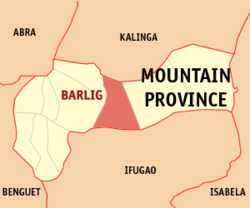Barlig
Barlig
Fialikia / Likaw-an | |
|---|---|
| Municipality of Barlig | |
 Barlig and surrounding rice terraces | |
 Map of Mountain Province with Barlig highlighted | |
Location within the Philippines | |
| Coordinates: 17°02′29″N 121°05′58″E / 17.0414°N 121.0994°E | |
| Country | |
| Region | Cordillera Administrative Region |
| Province | Mountain Province |
| District | Lone District |
| Barangays | 11 (see Barangays) |
| Government | |
| • Type | Sangguniang Bayan |
| • Mayor | Clark Chatongna Ngaya |
| • Electorate | 4,264 voters (2022) |
| Area | |
| • Total | 228.64 km2 (88.28 sq mi) |
| Population (2020 census)[3] | |
| • Total | 4,796 |
| • Density | 21/km2 (54/sq mi) |
| Time zone | UTC+8 (PST) |
| ZIP code | 2623 |
| PSGC | |
| IDD : area code | +63 (0)74 |
| Climate | Cfb |
| Income class | 5th municipal income class |
| Revenue (₱) | ₱ 90.64 million (2020) |
| Native languages | Bontoc Balangao Ilocano Tagalog |
Barlig, officially the Municipality of Barlig is a 5th class municipality in the province of Mountain Province, Philippines. According to the 2020 census, it has a population of 4,796 people.[3]
Barlig is bounded in the east by Natonin in the west by Bontoc and Sadanga. In the north, it is bounded by Tinglayan and in the south by the town of Mayoyao. The town is separated into three settlements or cluster of villages such as Barlig town proper, Lias and Kadaclan.[4]
The town of Barlig is home to two indigenous languages, the Finalig language and the Balangaw language. Both languages are in the brink of extinction, making them important languages in the field of language conservation. The two languages are also important for the survival of the Finalig culture and the Balangaw culture, respectively.
Barangays
Barlig is politically subdivided into 11 barangays.
- Chupac
- Fiangtin
- Kaleo
- Latang
- Lias Kanluran
- Lias Silangan
- Lingoy
- Lunas
- Macalana
- Ogoog
- Gawana (Poblacion)
Demographics
| Year | Pop. | ±% p.a. |
|---|---|---|
| 1939 | 1,827 | — |
| 1948 | 1,952 | +0.74% |
| 1960 | 2,972 | +3.56% |
| 1970 | 4,053 | +3.15% |
| 1975 | 5,138 | +4.87% |
| 1980 | 5,241 | +0.40% |
| 1990 | 6,273 | +1.81% |
| 1995 | 7,477 | +3.34% |
| 2000 | 6,351 | −3.44% |
| 2007 | 6,168 | −0.40% |
| 2010 | 5,838 | −1.98% |
| 2015 | 4,819 | −3.59% |
| Source: Philippine Statistics Authority[5][6][7][8] | ||
The people of Barlig are dominantly of Igorot and Ilocano descent. Locals call themselves Ifiallig which is a reference to someone born or have roots from villages. In the cluster of villages in Lias, people call themselves I-lias while those from Kadaclan villages call themselves Ekachakran. Despite living in a single town, the people speak different languages and probably traditions.[4]
Tourism
Barlig town boasts of its own rice terraces, the Barlig Rice Terraces in the near the center of the town and Lias Rice Terraces in the Lias, which is a cluster of villages. In Kadaclan, which is another cluster of villages, the annual Menaliyam festival is held.
Climate
Barlig has an oceanic climate (Köppen climate classification Cfb) closely bordering a subtropical highland climate ("Cwb") with relatively dry winters.
| Climate data for Barlig, Mountain Province | |||||||||||||
|---|---|---|---|---|---|---|---|---|---|---|---|---|---|
| Month | Jan | Feb | Mar | Apr | May | Jun | Jul | Aug | Sep | Oct | Nov | Dec | Year |
| Mean daily maximum °C (°F) | 21.3 (70.3) |
22.5 (72.5) |
23.5 (74.3) |
24.3 (75.7) |
24.4 (75.9) |
23.4 (74.1) |
22.5 (72.5) |
22.0 (71.6) |
22.5 (72.5) |
22.9 (73.2) |
22.3 (72.1) |
21.7 (71.1) |
22.8 (73.0) |
| Daily mean °C (°F) | 16.8 (62.2) |
17.6 (63.7) |
18.8 (65.8) |
19.8 (67.6) |
20.3 (68.5) |
19.8 (67.6) |
19.2 (66.6) |
18.8 (65.8) |
19.1 (66.4) |
19.1 (66.4) |
18.3 (64.9) |
17.6 (63.7) |
18.8 (65.8) |
| Mean daily minimum °C (°F) | 12.4 (54.3) |
12.7 (54.9) |
14.1 (57.4) |
15.3 (59.5) |
16.2 (61.2) |
16.2 (61.2) |
15.9 (60.6) |
15.7 (60.3) |
15.7 (60.3) |
15.4 (59.7) |
14.4 (57.9) |
13.6 (56.5) |
14.8 (58.6) |
| Average rainfall mm (inches) | 98 (3.9) |
54 (2.1) |
98 (3.9) |
162 (6.4) |
316 (12.4) |
350 (13.8) |
437 (17.2) |
489 (19.3) |
380 (15.0) |
330 (13.0) |
368 (14.5) |
184 (7.2) |
3,266 (128.6) |
| Source: [9] | |||||||||||||
Notable people
- Jeyrick Sigmaton [10]
References
- ^ Municipality of Barlig | (DILG)
- ^ "Province: Mountain Province". PSGC Interactive. Quezon City, Philippines: Philippine Statistics Authority. Retrieved 12 November 2016.
- ^ a b Census of Population (2020). "Cordillera Administrative Region (CAR)". Total Population by Province, City, Municipality and Barangay. Philippine Statistics Authority. Retrieved 8 July 2021.
- ^ a b http://barlig.wordpress.com/about
- ^ Census of Population (2015). "Cordillera Administrative Region (CAR)". Total Population by Province, City, Municipality and Barangay. Philippine Statistics Authority. Retrieved 20 June 2016.
- ^ Census of Population and Housing (2010). "Cordillera Administrative Region (CAR)" (PDF). Total Population by Province, City, Municipality and Barangay. National Statistics Office. Retrieved 29 June 2016.
- ^ Censuses of Population (1903–2007). "Cordillera Administrative Region (CAR)". Table 1. Population Enumerated in Various Censuses by Province/Highly Urbanized City: 1903 to 2007. National Statistics Office.
{{cite encyclopedia}}: CS1 maint: numeric names: authors list (link) - ^ "Province of Mountain Province". Municipality Population Data. Local Water Utilities Administration Research Division. Retrieved 17 December 2016.
- ^ "Climate data for: Barlig". Retrieved 2015-11-15.
- ^ http://www.gmanetwork.com/news/lifestyle/artandculture/567692/jeyrick-sigmaton-looks-like-a-top-asian-model-in-latest-shoot/story


